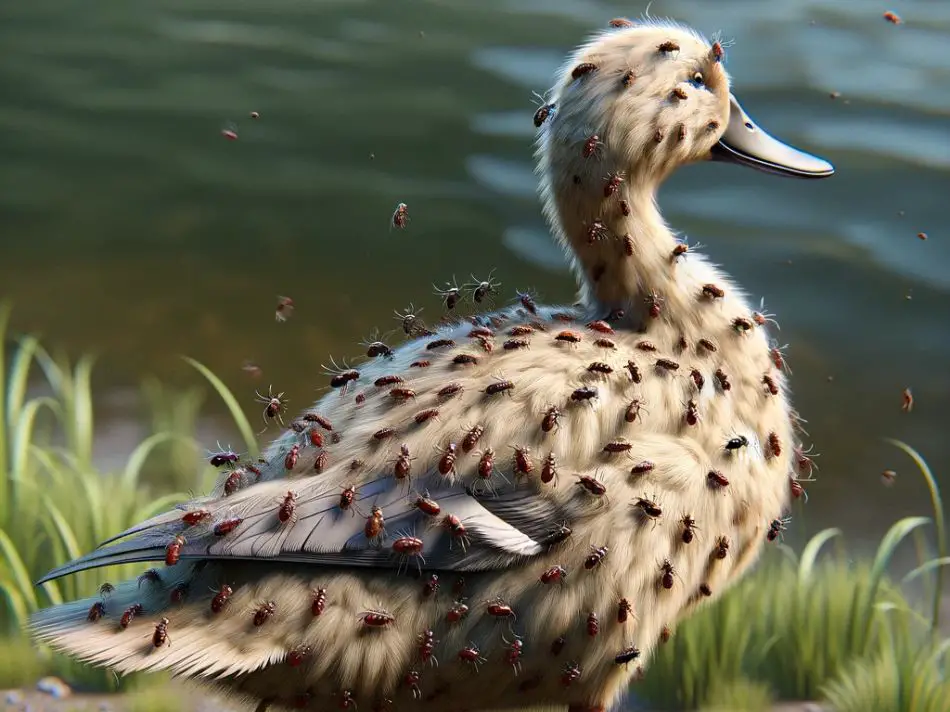Ducks, known for their resilience and adaptability, are not immune to the challenges posed by parasites, particularly fleas. While the image of a duck serenely gliding across a pond rarely conjures thoughts of flea infestations, the reality is that these waterfowl can, and do, become hosts to these pesky parasites.
Understanding the dynamics of flea infestations in ducks is crucial, not just for the health and well-being of the ducks, but also for those who care for them. Fleas can significantly impact the quality of life of these birds, manifesting in behaviors that indicate discomfort and distress.
Can Ducks Get Fleas?
The question of whether ducks can get fleas is one that might surprise many. Commonly associated with pets like dogs and cats, fleas are indeed capable of infesting ducks as well. These tiny parasites find a hospitable environment in the feathers and warm body of a duck, making these birds unsuspecting hosts.
Unlike the fleas commonly found on household pets, the fleas that infest ducks may have some differences in appearance and behavior, but their impact is similarly troublesome.
Ducks infested with fleas exhibit certain signs that are telltale indicators of the problem. These include excessive scratching, a noticeable decrease in energy or activity levels, and in severe cases, feather loss.
The fleas feed on the blood of the ducks, leading to irritation and discomfort. In some instances, the infestation can be so severe that it impacts the duck’s ability to carry out its daily activities, such as foraging and swimming.
Identifying a flea infestation early is key to ensuring the health and well-being of the duck. It requires careful observation, as the signs can be subtle at first. Understanding that ducks are susceptible to fleas is the first step in ensuring their health and happiness, and it underscores the importance of regular health checks and vigilant care for these birds.
Impact of Fleas on Ducks
Fleas, though small in size, can have a significant impact on the health and well-being of ducks. When a duck becomes infested with these parasites, the effects are not just superficial but can lead to more serious health issues. One of the most immediate and visible impacts of flea infestation is the change in the duck’s behavior.
Infested ducks often exhibit excessive preening and scratching, a natural response to the irritation caused by flea bites. This constant scratching can lead to feather loss, leaving the ducks vulnerable to temperature fluctuations and affecting their natural insulation and waterproofing.
Beyond the physical discomfort, fleas can severely affect a duck’s overall health. The persistent blood-sucking by fleas can lead to anemia, especially in younger or weaker birds. This condition, characterized by a reduction in the number of red blood cells, can diminish a duck’s vitality, making it lethargic and less responsive.
In severe cases, unchecked flea infestations can even be fatal, particularly for ducklings who are more susceptible to the rapid onset of anemia.The presence of fleas also has a direct impact on the productivity of ducks. For those raising ducks for eggs, a flea infestation can lead to a noticeable decrease in egg production.
The stress and discomfort caused by the fleas can disrupt the normal laying patterns, affecting both the quantity and quality of the eggs produced. This not only signifies a loss in potential revenue for duck farmers but also indicates a compromised state of health in the flock.
Treatment of Fleas in Ducks

Treating flea infestations in ducks is a critical step in ensuring their health and well-being. The approach to treatment is multifaceted, involving both direct intervention and preventive measures. When a flea infestation is identified, the first course of action is to eliminate the parasites.
This can be achieved through the use of specific powders or sprays containing active ingredients like trichlorfon or malathion, which are effective in killing fleas. It’s essential to select products that are safe for use on ducks, as their physiology differs from other common domestic animals.
Consultation with a veterinarian is highly recommended to ensure the correct product is chosen and applied properly. The vet can provide guidance on the dosage and frequency of application, tailored to the severity of the infestation and the specific needs of the ducks.
It’s important to treat all ducks in the flock, as fleas can quickly spread from one bird to another.
In addition to direct treatment, environmental management plays a crucial role. This includes thoroughly cleaning and disinfecting the ducks’ living quarters, bedding, and any areas where they spend time. Regular cleaning helps to remove flea eggs and larvae, preventing re-infestation.
It’s also important to monitor the ducks post-treatment, as multiple applications may be necessary to completely eradicate the fleas. Continuous observation for signs of re-infestation is key to ensuring the long-term health and comfort of the ducks.
Prevention of Flea Infestation

Preventing flea infestation in ducks is as crucial as treating it. Proactive measures can significantly reduce the risk of fleas, ensuring the health and comfort of the ducks. The cornerstone of prevention lies in maintaining a clean and hygienic environment for the ducks.
Regular cleaning of their living areas, including the coop, nesting boxes, and any outdoor spaces they frequent, is essential. This helps to eliminate potential breeding grounds for fleas and other parasites.
In addition to cleanliness, regular health checks are vital. Careful examination of the ducks, focusing on their feathers, skin, and particularly around the eyes, neck, and under the wings, can help in early detection of fleas or other parasites. Early identification of an infestation allows for prompt treatment, preventing the spread and escalation of the problem.
Another key aspect of prevention is the management of cohabitation spaces, especially if ducks are raised alongside other poultry like chickens. Since fleas can transfer between different bird species, ensuring all poultry are regularly checked and treated for fleas is important. This includes separate housing or quarantine measures for any new or sick birds to prevent the spread of parasites to the healthy flock.
Environmental control measures, such as using flea-repellent substances in bedding or around the coop, can also be effective. Natural options like diatomaceous earth can be used safely around ducks to help control flea populations.
By combining cleanliness, regular health checks, careful management of living spaces, and the use of environmental controls, the risk of flea infestation in ducks can be greatly minimized, promoting a healthier and more comfortable life for these birds.
Fleas and Human Health Risks
While the primary concern of flea infestations in ducks is the health and well-being of the birds, there is also a potential risk to humans. Duck fleas, like other animal fleas, can carry diseases and, in rare cases, may bite humans.
Although these instances are uncommon, they can lead to discomfort and health concerns.
One notable condition associated with duck fleas is ‘swimmer’s itch,’ also known as cercarial dermatitis. This occurs when people come into contact with water that is inhabited by ducks with flea infestations.
The fleas can mistakenly bite humans, causing allergic reactions characterized by itchy, red spots on the skin. These symptoms are generally mild and resolve on their own, but they can cause significant discomfort.
It’s important for people who handle ducks or spend time in environments where ducks live to be aware of these risks. Simple precautions, such as wearing protective clothing and promptly treating any flea infestations in ducks, can minimize the risk of transmission and ensure a safe and healthy environment for both humans and ducks.
Other Parasites That Can Be Found In Ducks
Apart from fleas, ducks are susceptible to a variety of other parasites that can affect their health. Understanding these parasites is crucial for comprehensive duck care and management.
- Lice are a common external parasite found in ducks. These pests live among the feathers, causing irritation and discomfort. A heavy lice infestation can lead to excessive preening, feather damage, and even feather loss, impacting the duck’s insulation and buoyancy.
- Mites are another concern for duck keepers. These tiny parasites can cause a range of issues, from skin irritation to feather loss. The Northern fowl mite and the red poultry mite are particularly problematic. They feed on the bird’s blood, potentially leading to anemia and decreased egg production. Regular checks, especially around the vent, neck, and under the wings, are essential for early detection and treatment.
- Scaly leg mites are a specific type of mite that targets the legs and feet of ducks, causing swelling, lameness, and crusty formations on the legs. While less common in ducks than in chickens, they can still pose a significant health risk.
- Ticks are another parasite that can infest ducks. These blood-feeding parasites can cause anemia, decreased egg production, and in severe cases, paralysis. They are often found in outdoor environments and can be challenging to control.
Effective parasite control involves a combination of regular health checks, maintaining a clean environment, and using appropriate treatments as needed. By staying vigilant and proactive, duck keepers can protect their flocks from these varied parasitic threats.
Conclusion: The Importance of Vigilance
The health and well-being of ducks are significantly impacted by flea infestations, underscoring the importance of vigilance in their care. Recognizing the signs of flea presence, understanding the impact on the ducks, and taking prompt, effective action are crucial steps in managing this issue.
Regular health checks, maintaining a clean environment, and being proactive in prevention and treatment are key to ensuring the health of these birds. This vigilance not only safeguards the ducks from discomfort and health risks but also ensures their productivity and quality of life.
Ultimately, the care and attention given to managing flea infestations reflect a commitment to the overall health and welfare of ducks.


